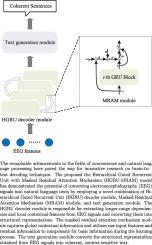Decoding text from electroencephalography signals: A novel Hierarchical Gated Recurrent Unit with Masked Residual Attention Mechanism
IF 7.5
2区 计算机科学
Q1 AUTOMATION & CONTROL SYSTEMS
Engineering Applications of Artificial Intelligence
Pub Date : 2024-11-16
DOI:10.1016/j.engappai.2024.109615
引用次数: 0
Abstract
Progress in both neuroscience and natural language processing has opened doors for investigating brain to text techniques to reconstruct what individuals see, perceive, or focus on from human brain activity patterns. Non-invasive decoding, utilizing electroencephalography (EEG) signals, is preferred due to its comfort, cost-effectiveness, and portability. In brain-to-text applications, a pressing need has arisen to develop effective models that can accurately capture the intricate details of EEG signals, such as global and local contextual information and long-term dependencies. In response to this need, we propose the Hierarchical Gated Recurrent Unit with Masked Residual Attention Mechanism (HGRU-MRAM) model, which ingeniously combines the hierarchical structure and the masked residual attention mechanism to deliver a robust brain-to-text decoding system. Our experimental results on the ZuCo dataset demonstrate that this model significantly outperforms existing baselines, achieving state-of-the-art performance with Bilingual Evaluation Understudy Score (BLEU), Recall-Oriented Understudy for Gisting Evaluation (ROUGE), US National Institute of Standards and Technology Metric (NIST), Metric for Evaluation of Translation with Explicit Ordering (METEOR), Translation Edit Rate (TER), and BiLingual Evaluation Understudy with Representations from Transformers (BLEURT) scores of 48.29, 34.84, 4.07, 34.57, 21.98, and 40.45, respectively. The code is available at https://github.com/qpuchen/EEG-To-Sentence.

从脑电图信号解码文本:具有屏蔽残留注意力机制的新型分层门控递归单元
神经科学和自然语言处理技术的进步为研究从大脑到文本的技术打开了大门,这些技术可以从人脑活动模式中重建个人看到、感知或关注的内容。利用脑电图(EEG)信号的非侵入式解码因其舒适性、成本效益和便携性而受到青睐。在 "脑到文本 "应用中,迫切需要开发有效的模型,以准确捕捉脑电信号的复杂细节,如全局和局部上下文信息以及长期依赖关系。针对这一需求,我们提出了分层门控递归单元与掩蔽残差注意机制(HGRU-MRAM)模型,该模型巧妙地将分层结构和掩蔽残差注意机制结合在一起,从而提供了一个稳健的脑到文本解码系统。我们在 ZuCo 数据集上的实验结果表明,该模型的性能明显优于现有基线,在双语评估研究得分(BLEU)、以召回为导向的术语评估研究(ROUGE)、美国国家标准与技术研究院度量标准(NIST)、显式排序翻译评估度量标准(METEOR)、翻译编辑率(TER)和具有转换器表征的双语评估研究(BLEURT)得分方面达到了最先进的水平。29、34.84、4.07、34.57、21.98 和 40.45 分。代码见 https://github.com/qpuchen/EEG-To-Sentence。
本文章由计算机程序翻译,如有差异,请以英文原文为准。
求助全文
约1分钟内获得全文
求助全文
来源期刊

Engineering Applications of Artificial Intelligence
工程技术-工程:电子与电气
CiteScore
9.60
自引率
10.00%
发文量
505
审稿时长
68 days
期刊介绍:
Artificial Intelligence (AI) is pivotal in driving the fourth industrial revolution, witnessing remarkable advancements across various machine learning methodologies. AI techniques have become indispensable tools for practicing engineers, enabling them to tackle previously insurmountable challenges. Engineering Applications of Artificial Intelligence serves as a global platform for the swift dissemination of research elucidating the practical application of AI methods across all engineering disciplines. Submitted papers are expected to present novel aspects of AI utilized in real-world engineering applications, validated using publicly available datasets to ensure the replicability of research outcomes. Join us in exploring the transformative potential of AI in engineering.
 求助内容:
求助内容: 应助结果提醒方式:
应助结果提醒方式:


